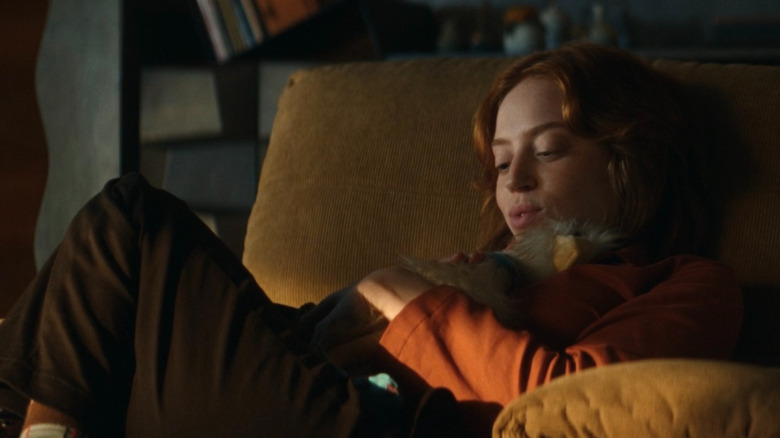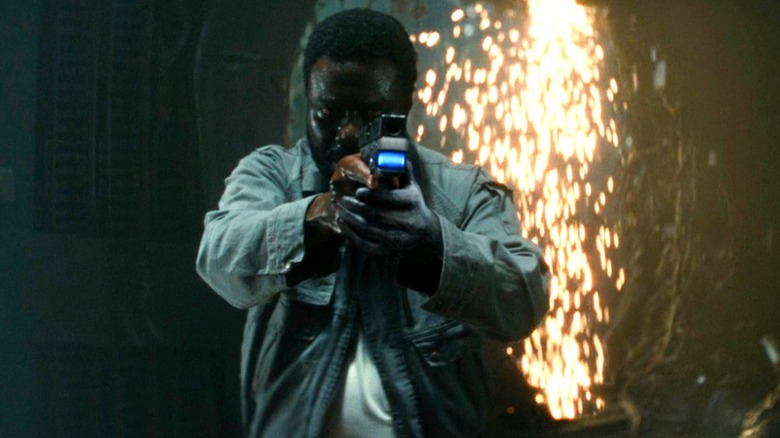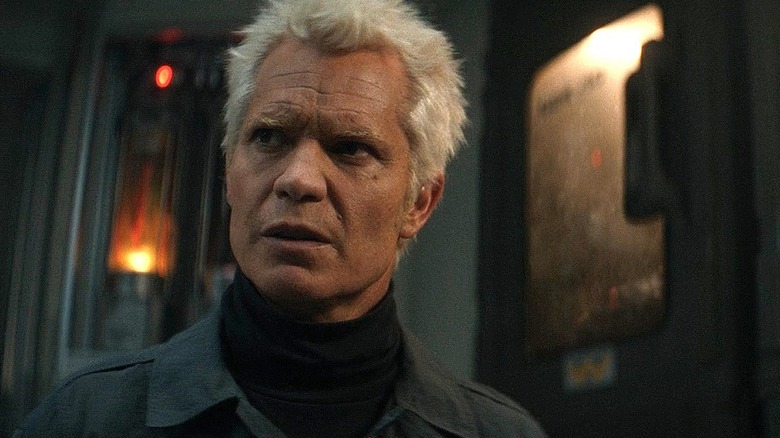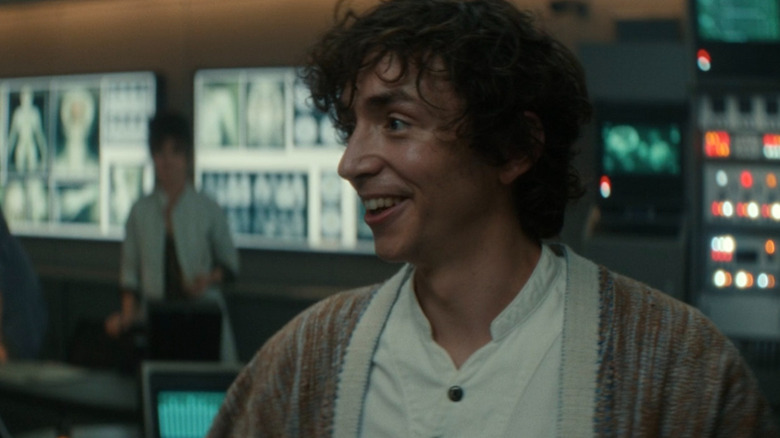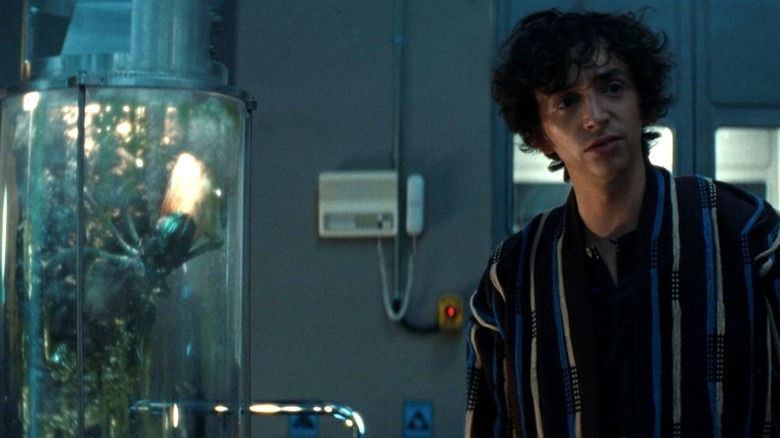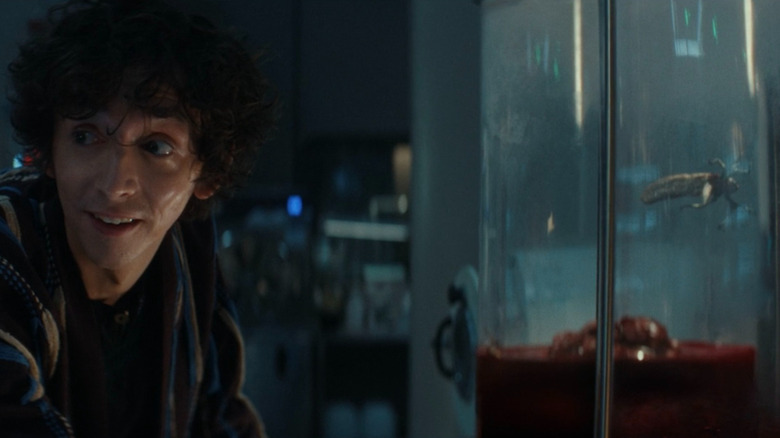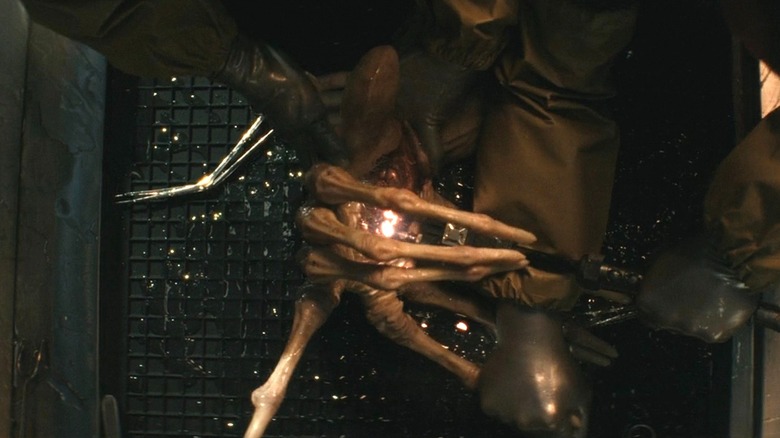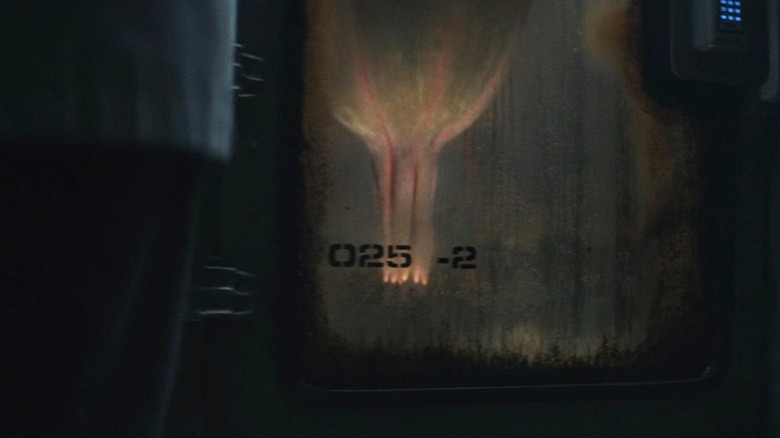Every Monster In Alien: Earth Ranked From Least To Most Dangerous
One could easily make the argument that the future of an entire franchise rested on the success or failure of FX's "Alien: Earth." The show is a dramatic deviation from the standard storytelling format for the Alien universe. Instead of focusing on a crew of space travelers being hunted by vicious Xenomorphs — as most installments in the Alien franchise do — showrunner Noah Hawley chose to explore an Earth-based storyline that actually finds its Xenomorphs largely contained for a good portion of the season.
Some fans may be bothered that Hawley has introduced several new species of alien to the universe, but most critics agree the show is a slam dunk, with a certified fresh Rotten Tomato score of 95% with critics. Part of what makes the Xenomorphs — as they have been from the first movie on — so scary is how much there is that humanity doesn't know or understand about them. Even bearing in mind the ending of "Alien: Covenant," there is so much about the creatures that viewers and in-universe characters don't know.
With the introduction of a new kind of person (for lack of a better word) and four entirely new alien species, "Alien: Earth" has forced us to consider the lethality of certain creatures and beings and where the most effort should be directed in trying to prevent rampant death and destruction. These rankings were partially determined by the overall body count of each species/type, an accounting of their strengths and weaknesses as they relate to physical conflict, and any special considerations based on the plot of "Alien: Earth."
10. Hybrids
Ranking the hybrids on "Alien: Earth" as the least dangerous killers on the show comes with the caveat that the hybrids are actually very lethal. They rank the lowest on this list because they have a fairly low body count by the end of the season, largely because they spend most of the season acting as if they are still children simply inhabiting synthetic bodies that look like adults. By the end of the season, though, every single hybrid has either died (RIP Isaac) or experienced a traumatic loss of innocence thanks largely to the actions of the humans, synthetics, and cyborgs that take advantage of them in various ways. No doubt the hybrids will prove far more dangerous when "Alien: Earth's" second season arrives.
By the end of Episode 8, Season 1's finale, Wendy (Sydney Chandler) and the other hybrids have collectively come to the conclusion that they are not exactly human and definitely not children. Wendy posits to her fellow "premium" beings that it's actually the humans who should fear the hybrids, and not the other way around, an argument that makes sense to them.
At this point, Nibs (Lily Newmark) is the best example viewers have of a "dangerous hybrid." The youngest of the kids to receive a new body, Nibs is traumatized by events on the USCSS Maginot and suffers from serious existential panic. When Dame Sylvia (Essie Davis) realizes she has, in her care, a traumatized child in the body of a high-tech killing machine, she takes steps to erase Nibs' memory. This violation just leads to more confusion and volatility, and, by the end of the show, Nibs has killed at least one person with her bare hands.
9. Cyborgs
Kumi Morrow (Babou Ceesay) is the chief security officer for deep-space exploration vessel the USCSS Maginot and a loyal employee of the Weyland-Yutani Corporation. The company paid for Morrow to become a cyborg — a human being who has been implanted or enhanced with synthetic parts — which is largely the reason he feels so beholden to the desires of the company. In pursuit of those desires, Morrow kills (at least) a couple dozen people, including first responders who are attempting to clear the wreckage of the Maginot. Not only does he directly kill many people, but Morrow is also indirectly responsible/accountable for some of the most upsetting deaths of the season.
Because of Morrow, Slightly (Adarsh Gourav) arranges the death of Arthur (David Rysdahl), and because of Morrow's orders from the company, the Maginot's first officer, Zaveri (Richa Moorjani), is eviscerated by a Xenomorph in the hallway outside the cockpit in which Morrow has sealed himself. Viewers don't see many moments of compassion or humanity from Morrow, but it is clear that, when not under explicit orders, he does try to limit loss of life, as exhibited when he saved Joe from the Xenomorph on the Maginot, and protect the weak, like many of the crew of the ship he was responsible for. Morrow is definitely lethal when he chooses, though — look out for Captain Hook's mutable arm!
8. Synthetics
Kirsh (Timothy Olyphant) and Morrow develop a quiet-but-seething rivalry throughout "Alien: Earth." Each has what the other can never have; Kirsh has the kind of power and omniscience of which a mortal man like Morrow can only dream, while Morrow, despite having synthetic parts, still gets the privileges of being human and, as such, is treated with a kind of inherent respect that Kirsh has rarely received. For most of the show, Morrow doesn't even realize he's playing a chess game with Kirsh over the aliens from the USCSS Maginot until it seems like he's lost. This is just one example of Kirsh's ability to see a larger picture, an ability that makes him incredibly dangerous to pesky little things like humans.
Kirsh is aware of Morrow's communications with Slightly from the start, but rather than report the situation to Boy Kavalier and ultimately rescue the naive hybrid from an agonizing situation, he allows Morrow's machinations to proceed. Rather than preventing Slightly from effectively murdering the engineer who created the hybrids' bodies and software, he waits for a new Xenomorph to burst from Arthur's chest and catches it before Morrow even knows it's missing. Kirsh is definitely an important part of how Noah Hawley's new series fits into the Alien franchise. In "Alien: Earth," we learn that synthetics have different motivations and methods, but all of them are dangerous because of their ability to see the whole board and wait very patiently to make their move.
7. Humans
Yeah, so, if there's one thing that every movie in the "Alien" franchise has confirmed, its that humans tend to be the worst. People are arrogant, greedy, aggressive, lazy, and cruel experts in self-delusion, and "Alien: Earth" does almost nothing to disprove any of these notions. One of the most prominent humans on the show, Boy Kavalier (Samuel Blenkin), is an arrogant whack-a-doo who seems to have come out of the womb ready to sling cruelties and slay business strategy. He is the funder of the hybrid project, and, with the help of Arthur and Dame Sylvia, he, as Wendy puts it in Episode 8, "put six children in the ground." In Episode 5, viewers learn that Kavalier actually arranged the crash of the SS Maginot and is thus responsible for countless deaths and injuries. And these are just two decisions from one guy.
Even the humans who are supposed to be easier to root for than trillionaires like Kavalier or ambitious narcissists like Dame Sylvia end up spewing a fair bit of nonsense on the show. Joe Hermit (Alex Lawther) is a first responder EMT and clearly a decent person from early on. That said, he still spends most of the show attempting to fit Wendy/Marcy into the same box his little human sister used to occupy. He also doesn't seem to understand Wendy's greater philosophical and ethical considerations regarding the alien species that have been brought aboard, referring to them as predators that will kill all of them if given the chance. He ultimately chooses to shoot Nibs rather than allow her to kill his friend, and it's clear that Wendy is worried this is a sign that he doesn't truly see the humanity in the hybrids.
6. Metal-eating flies
Unlike arrogant humans and hybrids who grossly underestimate extraterrestrial species in this universe on the regular, we take the threat of alien monsters seriously and could never claim that a human is more lethal than a living weapon. Even through a full accounting of the Alien Saga, readers won't find many aliens featured beyond the Xenomorphs. That's why it was bold of showrunner Noah Hawley to introduce four brand-new species to the universe, each one of them horrifying in its own unique way.
The audience doesn't learn too much at all about the mineral-eating fliers from the USCSS Maginot, even after they make a victim of Isaac (Kit Young) in Episode 6. While most of the aliens occupying the Neverland labs are lethal to organic species, these flying insects seem almost perfectly designed to destroy synthetics. After Isaac is trapped in the specimen holding space with these bugs, they slowly venture forth from their hive (a big dark mass in the corner of the ceiling with a hole in it) and quickly realize that Isaac is a walking, talking, tasty treat.
According to Kirsh, the giant flies likely sustain themselves on minerals due to a lack of flora and fauna on their original planet. Because of this, the insects actually digest their food outside of their body by spraying it with a strong acidic fluid, as they do to Isaac. It works almost instantly to dissolve his face along with other parts of his head and torso and would most likely still have stung even if Isaac had been organic. The reason these fliers are ranked low is because, like real-life flies, they seem to be quite slow and relatively easy to capture.
5. Species 19, the ticks
The audience is first introduced to Species #19, aka the ticks, when one of them comes upon a couple of first responders who have been tied up by Morrow. It's actually stressful to watch the bug crawl around the helpless servicemen, and when the tick eventually stabs its first victim in his neck, it's nearly a jump scare moment, even though everyone knows it's coming. The tick gorges itself on the blood of these men, and, by the time the hybrids find it, it has become a disgusting, throbbing mass of blood-filled, crawling tissue.
It seemed like this was going to be the only major horror moment for this specimen until Episode 5 revealed the events on the USCSS Maginot that led up to its crash into New Siam. The crew refers to these creatures as ticks, but it's clear that this label has lulled them into a false sense of security after one of the creatures easily lets itself out of its enclosure and squirts tiny little tadpoles into Chibuzo's (Karen Aldridge) water bottle while she isn't looking. Waiting for Chibuzo to drink the contaminated liquid is one of the most stressful parts of the entire series, and it's such a well-written moment of dramatic irony when young crew member Malachite (Jamie Bisping) is the one to take a swig.
The ticks pretty much seal the deal as being the fifth-scariest monster on the show when they grow in and escape from Malachite's stomach a little while later, having drunk all of his blood from the inside. When the ship's doctor, Rahim (Amir Boutrous), attempts to remove one of the ticks, he and Chibuzo are sprayed with a defensive toxin that kills them in seconds. These creatures really have a response for everything.
4. Facehuggers
Manumala noxhydria, or, as the humans affectionately refer to them, facehuggers, are actually the second stage in a Xenomorph's life cycle. Because they are such an iconic part of the Alien franchise, and because they are such a different threat from fully grown Xenomorphs, facehuggers warrant their own inclusion on this or any list of scary monsters. The description of them is fairly straightforward; when a living being approaches a Xenomorph egg, said egg slowly opens at the top and prepares to hatch a facehugger, a strong, eight-legged creature that moves very quickly and has only one purpose: to find a host for the infant parasite they carry.
Facehuggers find their host much more often than they don't, and once they have a hold of a person's (or any living fauna's) face, they latch on with all eight of their bone-strong limbs and insert a parasite into their victim via their mouth. The host lies unconscious for a while with the facehugger still attached, helping the parasite gestate in its organic host.
Maybe the worst part of the facehuggers is how, once a person is released by them, they suddenly seem to revert back to normal for a little while. They don't really remember what happened to them, but they still face the same fate as every host before them: to be killed when a baby Xenomorph bursts forth from their chest. The facehuggers are not the most difficult creatures to fight off in "Alien: Earth," and they ultimately don't have that high of a body count, but they get points for ensuring a terrifying, painful death.
3. The hanging plant creature
For the majority of "Alien: Earth," the final species captured by the USCSS Maginot in deep space remains something of a mystery. Upon first glance, the creature looks almost like a plant with an udder, hanging from the ceiling, as still as a cactus. The only time we see the monster move is when it extends a long, thin tendril to examine Isaac's head several different times, though it never does anything to actually hurt him. Due to how long this species remained dormant, with no exposition from Kirsh or Morrow, it needed to be absolutely horrifying when it finally made a move to prey on its captors — and boy, oh boy, is it.
It isn't until the climax of Episode 8 that the creature reveals its more active nature, when we see it scanning the head of Joe's first responder teammate and friend, Siberian (Diêm Camille). The main difference between Siberian and Isaac is that Siberian is made of flesh and blood, and it's clearly her organic body that prompts the hanging creature to go after her. As Siberian and Rashidi (Moe Bar-El) attempt to secure the lab at Neverland, the audience witnesses what appears to be the outline of a big, moth-shaped creature that can climb walls and is clearly able to become invisible. The creature climbs the ceiling until it's hovering over Siberian, quickly engulfing her from head to waist with its loose, leafy limbs.
Despite putting up as much of a fight as she could muster, Siberian is quickly killed as the monster seems to slowly digest her; the fact that it happens head-first is absolutely brutal. It will be interesting to see whether this one catches any characters off guard when the show eventually returns with a second season.
2. Xenomorphs
Over the years, many attempts have been made to explain the Xenomorphs and their origins in the Alien universe. They are parasitoids — animal organisms that implant parasitic larvae into living hosts so they can gestate and then kill the host when they mature — that can spawn from literally any living, organic tissue. This is evidenced in "Alien: Earth" by the Xenomorph that gestates inside Joe's discarded lung and eventually bursts forth. When they mature, they form a strong exoskeleton that operates as highly effective armor against ballistics and other weaponry and attacks. If something does manage to break through, their blood is infused with sulfuric acid that can easily harm or even kill most living organisms.
In addition to the incredible protection their bodies give them, Xenomorphs are super-effective predators. They possess superior reflexes, strength, and speed and have deadly sharp claws. Their tails are long, effectively operating like a third limb tipped with a sharp point. Xenomorphs also have a second, smaller headlike jaw and set of teeth designed to propel out of their outer mouths and kill their victim with something like a massively impactful headbutt.
Yes, the Xenomorphs are terrifying, but "Alien: Earth" has officially put forth a valid method for pacifying them thanks to Wendy's ability to communicate in their language and, apparently, give them orders. At the end of the show's first season, the Xenomorphs are presented as a weapon more than anything else — which is why they're not the worst monster in the series.
1. The skittering eyeball
When the skittering eyeball first reveals itself in "Alien: Earth," it's inhabiting the body of a deceased cat. Before the hybrids who have found it can reckon with the visual horror, the tentacled eyeball leaves the cat's body and immediately attempts to possess Nibs, Curly, or Smee as they try to capture it. It takes the hybrids a bit of time to secure the creature, and though they are operating with only 8-12 years of life experience, they still manage it thanks to their enhanced strength and reflexes.
The skittering eyeball is very fast and very agile upon first impression, and it only gets more terrifying from there. Even if someone never before wondered whether Xenomorphs have eyes, it's possible the question still occurred to them upon watching Episode 5 of "Alien: Earth." There, the eyeball reveals its intelligence by distracting Chibuzo while one of the ticks escapes its enclosure, and it doesn't hesitate to possess Shmuel (Michael Smiley) when given the chance. Despite plum, human accommodations, the eyeball immediately tries to level up and attack the Xenomorph, only to be swiped away after several failed attempts at finding an eye socket to invade.
The eyeball's parasitic abilities in and of themselves might not be more dangerous than the Xenomorph, but it eventually becomes clear that the alien is also very intelligent, despite its inability to directly communicate with the sentient beings holding it captive. Boy Kavalier discovers that the eyeball is familiar with the first six or so digits of Pi, and the idea of a creature smart enough to comprehend the digits of Pi — and, later, trap Isaac inside a cell with deadly creatures — being able to occupy a host nearly as strong as a Xenomorph with even greater intelligence is far more terrifying than a Xenomorph on its own.

